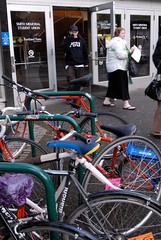
A new survey of students at the urban campus of Portland State University shows that drive-alone trips to campus are on the decline, while transit trips remain flat and bike trips swing upward. The “Student Commute Report” is done by the school’s Transportation and Parking Services division. The survey is undertaken for students every other year and it alternates with a similar survey of faculty and staff.
In the latest survey of a randomly selected group of 6,000 students (with just over a 10% response rate), 11% of them said they biked to campus. That compares to 39% who take transit, 25% who drive alone, and 14% who walk.
According to PSU’s Transportation Options Manager Ian Stude, a mix of factors has resulted in the decline in drive alone trips. He says improved access to transit infrastructure and higher-priced parking have been major factors. “The transit mall didn’t used to reach all the way to PSU… and then we got streetcar through campus in 2001 while at the same time we increased parking costs.”
Survey results show that transit trips have been flat for students, faculty and staff since 2004. About that trend, Stude said he feels “we have in some ways maxed out the number of people we can get onto transit.”
“Biking becomes far more appealing [than transit] because it’s much more economical, especially for students.”
— Ian Stude, Transportation Options Manager at PSU
Another reason more PSU commuters don’t take transit, Stude says, is cost. Even though the school negotiates with TriMet for special rates, Stude says they are beginning to see the limits of that subsidy. “Our transit trip growth has slowed significantly mostly because of cost to the user. It’s reaching a point where it’s still less than driving, but it’s not an easy cost. Biking becomes far more appealing because it’s much more economical, especially for students.”

PSU’s long-term plans include an increase of students from today’s 27,000 to about 40-45,000 in 2030. Stude says that with a “maxed out” transit ridership and the fact that they have no plans to increase car parking, bike trips is where the school is looking to expand.
On that note, similar to how transit infrastructure comes right to campus, Stude sees excellent potential for an even sharper uptick in bike trips once PBOT completes their planned bike projects. The city’s first cycle track is slated for construction this month. That bikeway will create a wide and safe route for people to bike up SW Broadway, directly adjacent to PSU. In addition, there are major bike infrastructure investments being forecast in the upcoming Bike Master Plan update.
Looking toward the future, Stude says he expects a similar increase in bike trips that they saw in transit trips from 2001-2003. “When we look at network planned for bikes in the near future, I think as much as 25% mode share for bikes is completely possible.”
The complete 2009 Student Commute Report is not yet available. You can view past reports here.


